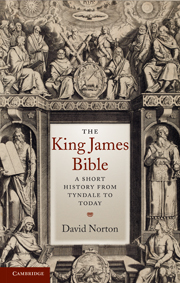Book contents
- Frontmatter
- Contents
- List of illustrations
- Preface
- List of abbreviations
- 1 Predecessors
- 2 Drafting the King James Bible
- 3 ‘I was a translator’
- 4 Working on the King James Bible
- 5 1611: the first edition
- 6 Printing, editing and the development of a standard text
- 7 Reputation and future
- Select bibliography
- Index
6 - Printing, editing and the development of a standard text
Published online by Cambridge University Press: 05 June 2012
- Frontmatter
- Contents
- List of illustrations
- Preface
- List of abbreviations
- 1 Predecessors
- 2 Drafting the King James Bible
- 3 ‘I was a translator’
- 4 Working on the King James Bible
- 5 1611: the first edition
- 6 Printing, editing and the development of a standard text
- 7 Reputation and future
- Select bibliography
- Index
Summary
If the appearance of the KJB sometime between March 1611 and February 1612 was marked in any special way, all record is lost. We do not even know if the King was pleased. It is as if it crept into the world with no more fanfare than a reprint of the Bishops' Bible. There is no Stationers' Company record of the publication because, presumably, that was what in effect it was: a revision of the Church's official Bible. Had not Broughton carried out his determination to censure it, it might seem that the KJB fell into a vacuum.
WHAT TO CALL THE NEW BIBLE
Coverdale's Bible gave its title first in Latin, then in English, ‘Biblia. The Bible’, adding, ‘that is, the Holy Scripture of the Old and New Testament’. The Matthew Bible omitted the Latin: it was ‘The Bible, which is all the Holy Scripture’. Taverner's was ‘The Most Sacred Bible, which is the Holy Scripture’. The Great Bible was, to begin with, ‘The Bible in English, that is to say the content of all the Holy Scripture’, then, even more prosaically, ‘The Bible in English of the largest and greatest volume’. Geneva was ‘The Bible and Holy Scriptures contained in the Old and New Testament’ (shortened to ‘The Bible’ in some editions from 1578 onwards). It was the Bishops' Bible that first used the words found in the KJB, ‘The Holy Bible, containing the Old Testament and the New’. Rheims-Douai also used ‘The Holy Bible’ in 1610.
- Type
- Chapter
- Information
- The King James BibleA Short History from Tyndale to Today, pp. 133 - 184Publisher: Cambridge University PressPrint publication year: 2011



